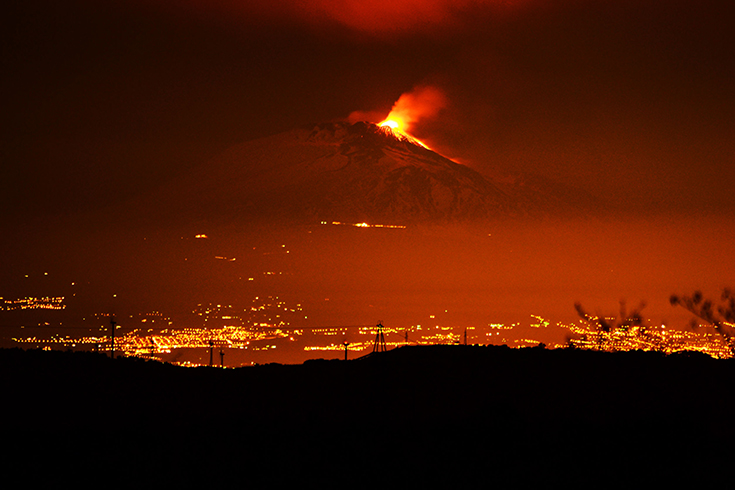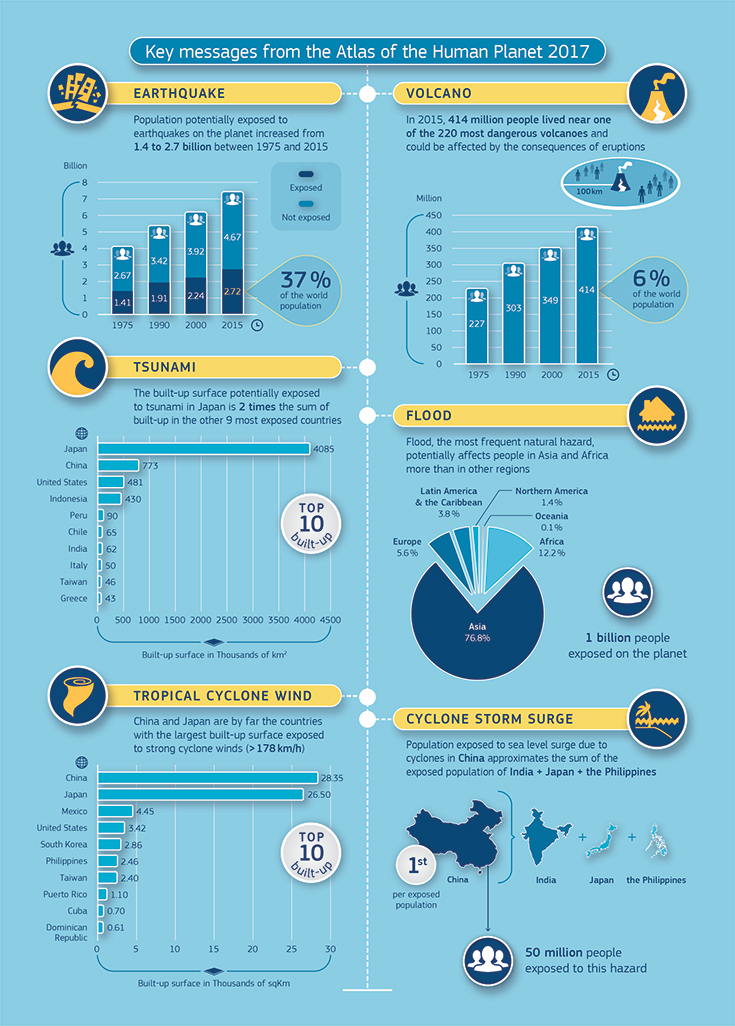Atlas of the Human Planet 2017 – how exposed are we to natural hazards?
One out of three people in the world is exposed to earthquakes, a number that almost doubled in the past 40 years. Around one billion people in 155 countries are exposed to floods and 414 million live near one of the 220 most dangerous volcanoes.
The 2017 edition of the JRC Atlas of the Human Planet looks at the exposure of people and built-up areas to the six major natural hazards, and its evolution over the last 40 years. More and more people and property are exposed to natural hazards,
The atlas covers six major natural hazards: earthquakes, volcanos, tsunamis, tropical cyclone winds, tropical cyclone storm surge and floods. Global exposure to these hazards has doubled between 1975 and 2015, mostly due to urbanisation, population growth and socioeconomic development. Some of the hazards pose a threat to a particularly large number of people in different regions of the world.

More than 400 milliion people live near one of the 220 most dangerous volcanoes in the world (photo: Orazio Puccio/123rf)
Earthquakes pose a threat to up to one third of the population
Of all hazards, the largest number of people are exposed to earthquakes. The number of people living in seismic areas increased by 93 per cent in 40 years (from 1.4 billion in 1975 to 2.7 billion in 2015). In 2015, more than 400 million people lived near one of the 220 most dangerous volcanoes, exposed to the consequences of possible eruptions.
Tsunamis affect coastal areas in many regions, with dangerous areas more concentrated in Asia. The highest amount of built-up surface exposed to tsunamis is in Japan by far, followed by China and the United States of America. Its population is four times more exposed than that of China, the second most affected country.
European map of natural hazards exposure
More than 170 million people in Europe are potentially exposed to earthquakes, almost a quarter of the total population. In Italy, Romania, or Greece the share of exposed over total population reaches over 80 per cent.
Flooding is the most common of the hazards studied. Germany has the highest number of people exposed to floods, about 8 million (10 per cent of the national population), followed by France with 5.7 million (nine per cent).
Eleven million Europeans live within 100 km from an active volcano, which eruptions could affect not only housing and settlements, but also everyday activities, including transportation. The potentially exposed built-up surface increased by 86% from 1975.
Most potential flood victims live in Asia
Exposure to floods, the most frequent natural disaster, is highest in Asia (76.9 per cent of the global exposed population) and in Africa (12.2 per cent). The world population potentially exposed to flood is around 1 billion in 155 countries in 2015. 11 per cent of the area built-up on Earth is potentially exposed to this hazard, too.
Tropical cyclones can shatter lives and homes in almost 90 countries
Tropical cyclone winds pose a threat to 1.6 billion people in 89 countries, up from one billion in 1975. In 2015, 640 million people were exposed to extremely strong cyclone winds, with the largest built-up surface exposed to strong cyclone winds found in China and Japan. Furthermore, 50 million Chinese are exposed to storm surge as consequence of tropical cyclones, up by almost 20 million in the last 40 years.
Global analysis of exposure and its development over the last 40 years helps us better understand what affects disaster risk over time and risk drivers. It is also useful in identifying effective policy actions for more resilient communities.
The exposure data and the findings of the Atlas support the implementation of the post-2015 international frameworks: the UN Framework Convention on Climate Change, the Sendai Framework for Disaster Risk Reduction 2015-2030, the Sustainable Development Goals (SDGs), and the New Urban Agenda (Habitat III). The Global Human Settlement Layer (GHSL, see below) baseline data provides insights into developments over the last 40 years and into the impact that policies have on them. Researchers and policy makers can also use the data to aggregate exposure information at all geographical scales, from the city level to the region, continent and global.
How to estimate the exposure?
The Atlas of the Human Planet 2017 builds on its first edition published in 2016, in which JRC scientists combined earth observation with spatial modelling techniques to create the Global Human Settlement Layer (GHSL). The GHSL is the first global, fine scale, multi-temporal and open data on the physical characteristics and the dynamics of human settlements, covering 40 years of satellite observations data. The GHSL dataset has been now combined with the best available global hazard maps to measure the potential exposure to natural hazards over time.
The atlas was presented during the 2017 Global Platform for Disaster Risk Reduction meeting in Cancun, Mexico. The JRC also presented a report, Science for Disaster Risk Management 2017: knowing more and losing less, a flagship product of the European Commission's Disaster Risk Management Knowledge Centre (DRMKC), compiling the state-of-the-art in disaster risk management.

Click here to download a PDF of the full report